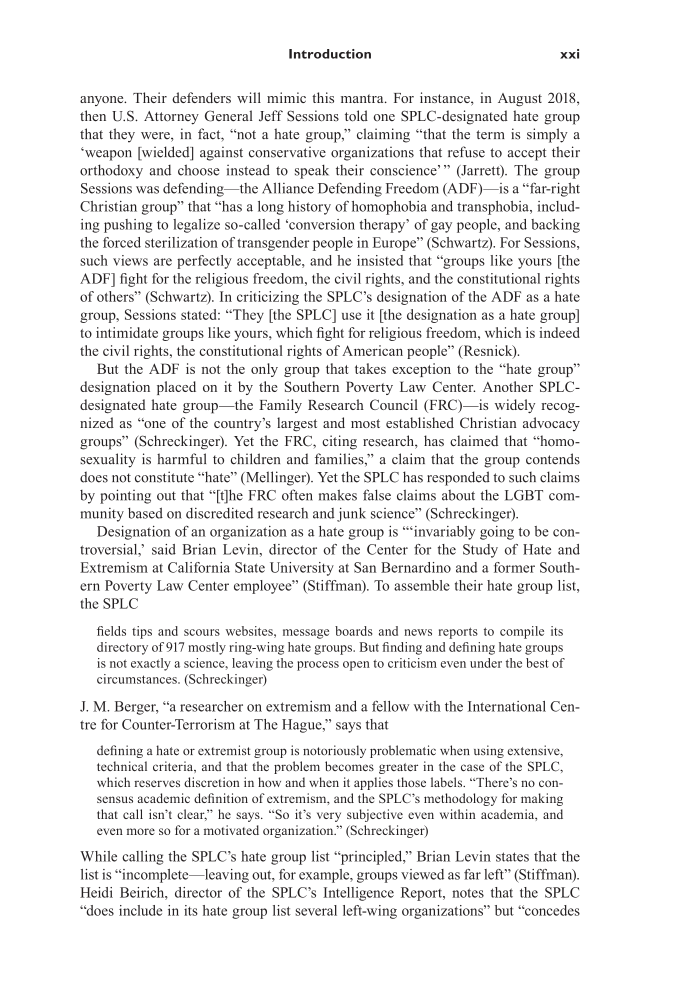Introduction xxi anyone. Their defenders will mimic this mantra. For instance, in August 2018, then U.S. Attorney General Jeff Sessions told one SPLC-designated hate group that they were, in fact, “not a hate group,” claiming “that the term is simply a ‘weapon [wielded] against conservative organizations that refuse to accept their orthodoxy and choose instead to speak their conscience’ ” (Jarrett). The group Sessions was defending—the Alliance Defending Freedom (ADF)—is a “far-right Christian group” that “has a long history of homophobia and transphobia, includ- ing pushing to legalize so-called ‘conversion therapy’ of gay people, and backing the forced sterilization of transgender people in Europe” (Schwartz). For Sessions, such views are perfectly acceptable, and he insisted that “groups like yours [the ADF] fight for the religious freedom, the civil rights, and the constitutional rights of others” (Schwartz). In criticizing the SPLC’s designation of the ADF as a hate group, Sessions stated: “They [the SPLC] use it [the designation as a hate group] to intimidate groups like yours, which fight for religious freedom, which is indeed the civil rights, the constitutional rights of American people” (Resnick). But the ADF is not the only group that takes exception to the “hate group” designation placed on it by the Southern Poverty Law Center. Another SPLC- designated hate group—the Family Research Council (FRC)—is widely recog- nized as “one of the country’s largest and most established Christian advocacy groups” (Schreckinger). Yet the FRC, citing research, has claimed that “homo- sexuality is harmful to children and families,” a claim that the group contends does not constitute “hate” (Mellinger). Yet the SPLC has responded to such claims by pointing out that “[t]he FRC often makes false claims about the LGBT com- munity based on discredited research and junk science” (Schreckinger). Designation of an organization as a hate group is “‘invariably going to be con- troversial,’ said Brian Levin, director of the Center for the Study of Hate and Extremism at California State University at San Bernardino and a former South- ern Poverty Law Center employee” (Stiffman). To assemble their hate group list, the SPLC fields tips and scours websites, message boards and news reports to compile its directory of 917 mostly ring-wing hate groups. But finding and defining hate groups is not exactly a science, leaving the process open to criticism even under the best of circumstances. (Schreckinger) J. M. Berger, “a researcher on extremism and a fellow with the International Cen- tre for Counter-Terrorism at The Hague,” says that defining a hate or extremist group is notoriously problematic when using extensive, technical criteria, and that the problem becomes greater in the case of the SPLC, which reserves discretion in how and when it applies those labels. “There’s no con- sensus academic definition of extremism, and the SPLC’s methodology for making that call isn’t clear,” he says. “So it’s very subjective even within academia, and even more so for a motivated organization.” (Schreckinger) While calling the SPLC’s hate group list “principled,” Brian Levin states that the list is “incomplete—leaving out, for example, groups viewed as far left” (Stiffman). Heidi Beirich, director of the SPLC’s Intelligence Report, notes that the SPLC “does include in its hate group list several left-wing organizations” but “concedes
Document Details My Account Print multiple pages
Print
You have printed 0 times in the last 24 hours.
Your print count will reset on at .
You may print 0 more time(s) before then.
You may print a maximum of 0 pages at a time.






















































































































































































































































































































































































































































